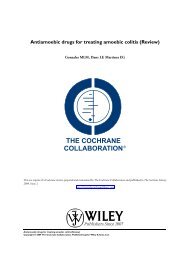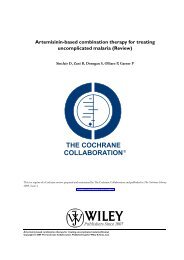Legislative smoking bans for reducing secondhand smoke exposure ...
Legislative smoking bans for reducing secondhand smoke exposure ...
Legislative smoking bans for reducing secondhand smoke exposure ...
Create successful ePaper yourself
Turn your PDF publications into a flip-book with our unique Google optimized e-Paper software.
Cesaroni 2008 (Continued)<br />
Outcomes Smoking prevalence as measured by self-reported <strong>smoking</strong> status. Age-standardised rates of acute coronary events<br />
annually, stratified prior to analysis by age categories 35-64 yrs, 65-74 yrs, 75-84 yrs <strong>for</strong> 2000-2005. Acute coronary<br />
event defined as acute myocardial infarction (AMI) and other acute and subacute <strong>for</strong>ms of ischemic heart disease,<br />
ICD-9, Code 411. Myocardial infarction defined as all diagnosis with principle diagnosis of AMI (ICD-9-CM code<br />
410) or a secondary diagnosis of AMI where principal diagnosis indicated AMI complications. Two events occurring<br />
within 28 days of each other were analysed as one single episode.<br />
Biochemical verification: No<br />
Notes Possible confounders are that measurement of troponin as a new diagnostic criteria <strong>for</strong> AMI became available in<br />
hospitals in Rome during the study period. There was an increase in daily dose of cardiac medication such as statins<br />
from 10 to 55 per 1000 residents when this study was carried out. Other outcomes are economic impact as measured<br />
from cigarette sales in Rome, air quality by average concentrations of PM10, temperature and flu epidemics.<br />
Eagan 2006<br />
Methods Country: Norway<br />
Setting: Hospitality premises<br />
Design: Cohort study, pre and 5 months follow-up surveys. Analysis: McNemar’s test <strong>for</strong> change in symptom<br />
prevalence and ANOVA <strong>for</strong> repeated measures. Chi 2 <strong>for</strong> the <strong>exposure</strong> variables, and test <strong>for</strong> trend <strong>for</strong> the symptom<br />
variables to test differences in baseline characteristics by response or non-response at follow up.<br />
Participants Employees in a random sample of companies.<br />
Baseline: 1525 employees participated<br />
Follow up: 906/1525 responded 5 months post-ban, 59% response rate<br />
Cohort sample : Females 51.9%; Age 15-29 yrs 38%, 30-39 yrs 30%, 40+ 31.8%; Smokers (persistent and starters)<br />
56%.<br />
Missing outcome data: Used Chi 2 to test <strong>for</strong> differences in baseline characteristics between respondents and nonrespondents<br />
at follow up. No difference except in response rate of <strong>smoke</strong>rs (57.4%) and non<strong>smoke</strong>rs (62.6%). No<br />
difference between respondents and non-respondents in baseline prevalence <strong>for</strong> any of the respiratory symptoms.<br />
Interventions <strong>Legislative</strong> <strong>smoking</strong> ban introduced in Norway on 1st June 2004 in indoor workplaces including <strong>smoking</strong> in bars,<br />
nightclubs and restaurants.<br />
Outcomes Self-reported <strong>smoking</strong> status<br />
Self-reported <strong>exposure</strong> to SHS<br />
Prevalence of self-reported respiratory symptoms be<strong>for</strong>e and 5 months post-ban. Respiratory symptoms included<br />
were morning cough, daytime cough, phlegm cough, dyspnoea and wheezing.<br />
Biochemical verification: No<br />
Notes An incentive of prize money was offered to one randomly selected participant. Exposure to SHS and <strong>smoking</strong> status<br />
were also recorded at baseline.<br />
<strong>Legislative</strong> <strong>smoking</strong> <strong>bans</strong> <strong>for</strong> <strong>reducing</strong> <strong>secondhand</strong> <strong>smoke</strong> <strong>exposure</strong>, <strong>smoking</strong> prevalence and tobacco consumption (Review)<br />
Copyright © 2010 The Cochrane Collaboration. Published by John Wiley & Sons, Ltd.<br />
30








